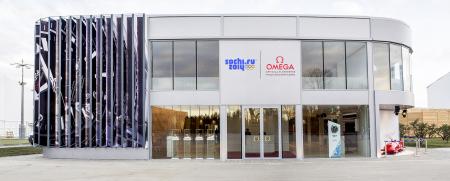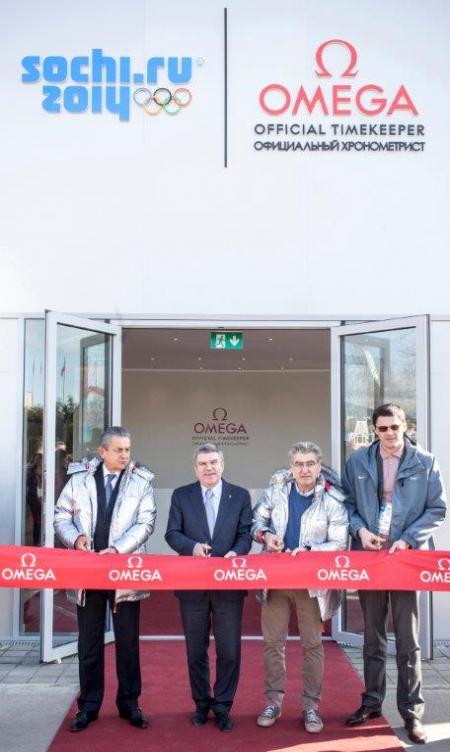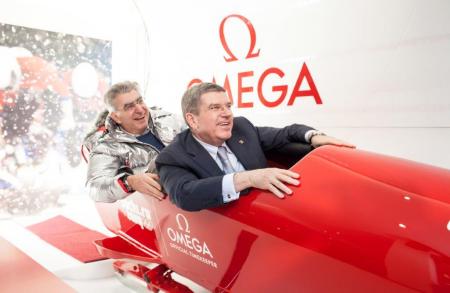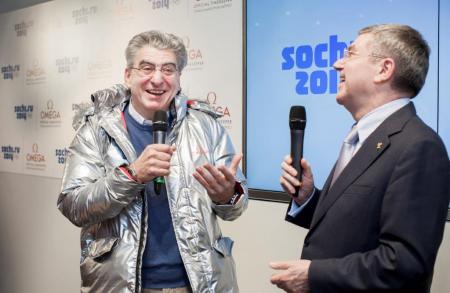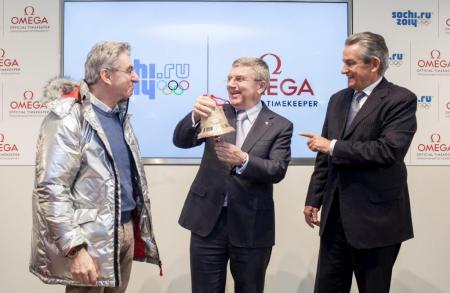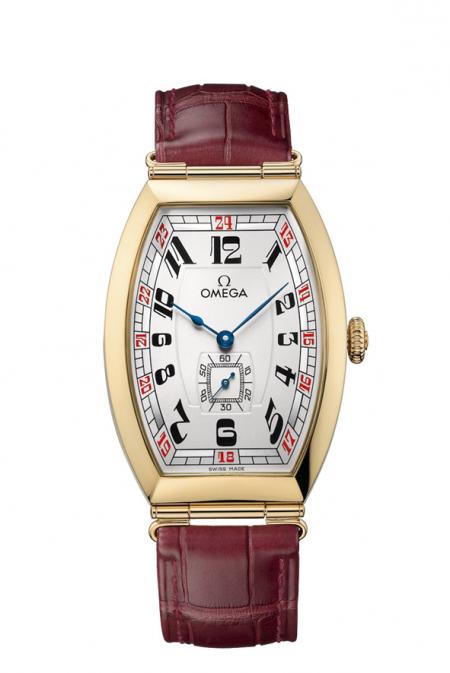OMEGA at the 2014 Sochi Olympic Games
OMEGA and the Olympic Winter Games:
Celebrating 78 years of passion at Sochi 2014!
Just a few days remain until the Sochi 2014 Olympic Winter Games Opening Ceremony on 7 February 2014, and nine OMEGA Countdown Clocks spread across the Russian Federation have been meticulously counting down the days, hours, minutes and seconds until the vibrant celebration takes place and OMEGA assumes its Official Timekeeping responsibilities for the 26th time since 1932. On 7 March, the brand will play the same role at the Paralympic Winter Games.
In 1936, OMEGA served as Official Timekeeper at its first Olympic Winter Games in Garmisch-Partenkirchen, Germany – a single technician was equipped with just 27 OMEGA stopwatches used to time every event. For more than 75 years, the brand has enriched its tradition of innovation and has been behind the invention and introduction of some of the most advanced sports timekeeping technologies.
OMEGA’s presence at the Sochi 2014 Olympic Winter Games will be impressive: 260 on-site professionals supported by 170 trained volunteers 230 tons of equipment including 30 public and 90 sports scoreboards, 78 km of cables and optical fibre and state-of-the-art timekeeping and data-handling technology developed by OMEGA and adapted to the requirements of each sport.
With its deep-rooted and rich sporting history, OMEGA is thrilled to take part in another edition of the Olympic and Paralympic Games where the world’s greatest winter athletes will compete for gold in Sochi’s dynamic landscape. As Official Timekeeper, we are proud to work with the IOC, sporting federations and athletes to ensure that the timekeeping technology used at the Sochi 2014 Olympic and Paralympic Winter Games fuels the Olympic spirit and captures every defining split-second.
HIGHLIGHTS OF TIMEKEEPING AT THE OLYMPIC WINTER GAMES
At the Sochi 2014 Olympic Winter Games, OMEGA, the Official Timekeeper, will bring its century-long history of international sports timing and a legacy at the Olympic Games which began in 1932. OMEGA’s timekeeping and data handling team will draw on the experience gained at 25 Olympic Games and the competence that has given the brand an unparalleled reputation as a precision sports timekeeper.
Here is a short review of some of OMEGA’s timekeeping highlights at the Olympic Winter Games.
1932 was a defining moment in the history of sports measurement: Omega became Official timekeeper at the Los Angeles Games in 1932, supplying 30 high precision chronographs, all of which had been certified as chronometers by the Observatory at Neuchâtel, for use across all sports. It was the chronographs’ officially certified precision which convinced the Olympic Organizing Committee of the Olympic Games to select Omega for the Games. Official results were taken at fifths and tenths of a second.
1948
Omega used the cellular photoelectric eye for the first time at the 1948 Olympic Winter Games in St. Moritz. Mobile and independent of the electrical network, it was water-resistant and could be adjusted to resist wide variations in temperature; its infrared technology was insensitive to the so-called parasitic reflection of the sun and flashes. For the first time, the timing system was triggered automatically when the starting gate opened.
1956
Starting gates were used for the first time in Alpine skiing at the 1956 Winter Games in Cortina d’Ampezzo, Italy. The start time was automatically triggered by an acoustic traffic-light signal, the buzzer timed to the red – yellow – green countdown.
1964
Invented in 1961, the Omegascope allowed the introduction of the concept of real time in televised sports reporting by superimposing luminous numbers on the bottom of the screen; it revolutionized timekeeping and left no margin for error because it was openly on display for millions of TV viewers. It was used at the 1964 Olympic Winter Games in Innsbruck, the first fully electronic Olympic Games. Never before had spectators beyond a venue been so quickly and well informed about events taking place elsewhere.
1968 ‘Integrated timing’ was introduced at the Games in Grenoble, where automatic and electronic timekeeping was used for the first time, providing statistical analysis with results being fed to judges, coaches, media and, to some degree, the public. The birth of the photoprinter ensured that results were more rapidly and widely distributed than ever before. The concrete realization of modern timekeeping was a historic turning point for OMEGA.
1980
The Omega Game-O-Matic, which calculated and displayed an athlete’s ranking the moment he or she crossed the finish line, was used for the first time at the Winter Games in Lake Placid.
1988
Calgary was the first Olympic Games with computerised timekeeping, results and analysis stored in databases for posterity.
1992
At the 1992 Winter Games in Albertville, speed skaters were treated to the Omega Scan-O-Vision system that digitally measured times to the nearest thousandth of a second as the skaters crossed the finish line. The system effectively photographed time by fusing time and continuous picture in a single document. This heralded a new chapter in the science of timekeeping.
2006
At the Winter Games in Turin in 2006, transponders were strapped to the ankles of speed skaters so that timekeepers might capture a moment of sudden acceleration, the speed round a hairpin bend, the abrupt end to a challenge as a racer crashed to the ice.
2010
The most talked-about bit of new sports timekeeping equipment In Vancouver was the new Electronic Start System. One of the most enduring images from any Olympic Games is the starting pistol, reminiscent of the revolvers so popular in movies set in the Old West. At Olympic and Paralympic Winter Games, this was replaced by a streamlined, futuristic device composed of a flash gun and a sound generation box. When the starter presses its trigger, three things happen simultaneously: a sound is “played”, a light flash is emitted and a start pulse is given to the timing device. By pressing the trigger a second time within two seconds, the false start is audibly signalled. The sounds can be changed and downloaded by computer.
TIMEKEEPING TECHNOLOGIES AT THE SOCHI 2014 OLYMPIC WINTER GAMES
OMEGA Measurement Unit: G-force, speed and acceleration in bobsleigh
A world premiere in Sochi is the use of new technology in bobsleigh races that makes important in-run data available instantly to the competitors and their teams and to TV viewers around the world. The information is gathered by the OMEGA Measurement Unit mounted on each bob.
This innovative new device consists of a speed sensor, a 3D acceleration sensor and a 3D gyro-sensor, all of which acquire data in real time.
The speed sensor records the bob’s speed throughout the entire run. The 3-axis gyro-sensor continuously determines the angular velocity of the bob. Angular velocity is the speed of the bob as it rotates around the track and is measured as the rate of change of the angle of the bob subtended at that point on the track by the path of the bob. The 3-axis acceleration sensor allows continuous determination of the forces acting on the driver during the run, with each axis measuring a different acceleration parameter.
The OMEGA Measurement Unit benefits bobsleigh racers and their teams because it gives them immediate access to data that allow them to adapt and improve their training programs.
The development of the OMEGA Measurement Unit
The development of the OMEGA Measurement Unit started in October 2011 and it provided some interesting challenges. On one hand, data captured would have to be comprehensive enough to serve as a basis for in-depth post-race analyses by coaches and technicians. On the other, a nearly undelayed wireless transmission combined with fast and simple processing was considered essential due to the demands of real-time visualization of the live data.
Its development was motivated by the introduction of the OMEGA Monobob Series and its association with the small, sleek, aerodynamic one-person bobsleighs made it possible to advance the technology very quickly.
A relatively simple early prototype of the unit was assembled. Intending to keep things basic at this stage, the designers did not include certain features, such as the wireless transmission function, that would later be crucial. Accordingly, sensor data had to be recorded directly on a mini-PC mounted beside the prototype circuit inside the bobsleigh chassis. Obviously, the system at this point was large and heavy but the three basic sensor components – the radar, gyro and accelerometer – performed well.
In late 2011, the design team alternated outdoor tests and indoor evaluations at short intervals and early in the following year, it was already possible to present the first video clip, showing live camera footage combined with a graphics insert that was after the run from synchronized sensor data.
Much of 2012 was dedicated to refining the wireless transmission part of the project and after months of evaluation and a redesign of the unit, a prototype was ready for extensive on-site testing in the 2012/2013 season. It was clear that almost every objective had been achieved, including live data transmission and the insertion of live data from multiple bobsleighs into television graphics.
The OMEGA Measurement Unit is fully tested and ready to add to the excitement of the bobsleigh events at the Sochi 2014 Olympic Winter Games.
Electronic Start System
The electronic starting gun that was launched in Vancouver will once again attract a considerable amount of attention. Although Sochi 2014 will be its third Olympic Games, the bright red device that looks like it escaped from a science fiction story continues to generate interest wherever it is used.
When the starter presses the trigger, three things happen immediately and simultaneously:
• A light flash is emitted
• A sound is generated through speakers behind each competitor
• A start pulse is transmitted to the timing device. If the trigger is pressed a second time within two seconds, the false start will be audibly signaled.
These pistols, numbering five, are used for Speed Skating and Short Track Speed Skating. They were also used at the London 2012 Olympic Games for Track Cycling.
One of the reasons that OMEGA decided to develop this new type of pistol was the increasingly stringent security measures at airports and in stadiums. A classic starting pistol is a modified firearm which is not capable of shooting real bullets but of firing blanks. Their familiar shape, however, makes them difficult to get through
security screening.
Scan’O’Vision Photofinish Camera
?No matter how well intentioned, the human eye has its limitations. At the finish line, it was replaced by a highly sensitive photoelectric cell which instantaneously stopped the chronograph, while a lightning-fast electric current eliminated inconsistencies caused by timekeepers’ reaction times. In sprints and races with grouped finishes, there was the possibility that there would be no space between the athletes crossing the finish line so other timekeeping systems had to be used in support of the photoelectric cells. The photoelectric cell placed at the finish line dramatically outperformed all previous timing devices and in time, replaced the finishing tape.
Since the Vancouver 2010 Olympic Winter Games, the OMEGA Scan’O’Vision photofinish camera has been used to determine the official finishing times of the competitors in a race. During the speed skating events, as soon as a competitor’s skate crosses the finish line, the running times on the scoreboard and television superimpositions is stopped – but ultimately it is the photofinish camera that has measured and captured the result that will be deemed official.
An anecdote: Ice skating ladies pursuit in Vancouver
In the semi-final against the USA, one of the German competitors fell just before crossing the finish line. She extended her leg so that the tip of the skate crossed the line and she narrowly defeated her American rival.
Photoelectric Cells
There are two photo cells at the end of the track, set at different heights in order to ensure that they are triggered by the competitor’s skate. For an accurate result, both photo cells need to be triggered to establish and record the race time. There are some key factors in determining the results in a race.
At the London 1948 Olympic Games, OMEGA used its photoelectric cell for the first time at a summer Olympic Games. The now ubiquitous “slit” photofinish camera, developed by a British firm called Race Finish Recording Company, also made its Olympic Games debut.??This photoelectric cell could determine precisely when the competitors crossed the finish line. However, in some events, the athletes finished so tightly grouped that it was sometimes impossible to tell, beyond a shadow of a doubt, what the finishing order had been. The photofinish camera recorded an image that could be developed in about eight minutes, removing any question about who would claim the gold, silver and bronze medals.??More than six decades after these ground-breaking technologies were introduced, their descendants remain an essential cornerstone in the timing of world-class events. The combined use of photoelectric cell technology and photofinish images changed sports timekeeping forever.
Transponders
The incredibly lightweight and discreet transponder equipment will be attached to each competitors’ left and right legs, making it possible for OMEGA to measure, record and display the intermediate times and rankings of the participating athletes and teams while the race is taking place.
The Snowgate starting gate
Alpine skiers at this Olympic Games will start their runs through a starting gate called “Snowgate”. This technology ensures that the starting pulse is generated when the “wand” (or “bar”) is at precisely the same angle for every competitor. The control box for the device includes both a main and a backup system. The systems use different technologies – one is purely mechanical; the other is electro-mechanical. The skiers have a ten-second starting window and can begin up to five seconds before or five seconds after the official start time. If they are within this time frame, the timing system will be activated automatically when they burst through the gate; otherwise, they are disqualified.
TIMEKEEPING FOCUS: SPEED SKATING
There are twelve speed skating medal events. Women compete at distances of 500m, 1000m, 1500m, 3000m, and 5,000m with an added team pursuit event. Men’s distances are 500m, 1000m, 1500m, 5,000m and 10,000m. There is also a men’s team pursuit event. Speed skating has been part of the Olympic Games since the first Winter Games were held in Chamonix in 1924. Women’s speed skating became a full medal event at the Squaw Valley 1960 Olympic Winter Games. With speeds of more than 60 kilometres per hour, speed skating is the fastest human-powered, non-mechanical-aided sport in the world.
During the race, a lap counter located near the finish line lets skaters know how many laps remain. The finish time is determined when the blade of the skate crosses the photo-beam located on the surface of the ice at the finish line. In case of disputes, OMEGA Scan’O’Vision photofinish camera records the action at the finish line at 2,000 frames per second.
In speed skating the timekeepers and their technologies face the ultimate challenge: it is timed to the nearest thousandth of a second. To put this in perspective, about a thousand of these tiny increments of time pass in the second or so it takes to say “Olympic speed skating”.
TIMEKEEPING FOCUS: ALPINE SKIING
The ten alpine ski medal events, downhill, super-G, slalom, giant slalom and super-combined, with men’s and women’s events in each discipline, will all take place at the Rosa Khutor Alpine Center. Alpine skiing for both men and women debuted as an Olympic sport in 1936 at Garmisch-Partenkirchen. In 1948, separate downhill and slalom races were added. Super combined was not contested at an Olympic Winter Games until 1988, in Calgary. The giant slalom was added in 1952, and the super-G in 1988.
The speed and drama of the alpine events make them among the most popular of all Olympic winter sports. Athletes can reach speeds in excess of 130 kilometres per hour as they travel down a vertical drop that ranges from 180 metres (slalom) to 1,100 metres (downhill) for men and 140 metres (slalom) to 800 metres (downhill) for women. The skiers also have to pass through a series of gates. A skier who misses a gate has to climb back up and go through the gate in order not to be disqualified.
Alpine skiers start their runs through the Snowgate starting gate, which ensures that the starting pulse is generated when the “bar” is at precisely the same angle for every competitor. The skiers have a ten-second starting window and can begin up to five seconds before or five seconds after the official start time indicated on the start clock. Laser photocells record intermediate and final times and the Scan’O’Vision camera captures the thrilling finishes – 2000 times per second.
TIMEKEEPING FOCUS: BOBSLEIGH
Four-man bobsleigh was on the schedule at the first Olympic Winter Games in 1924. The current Olympic bobsleigh events are in some ways reminiscent of those pioneering days of the sport but the modern bobsleighs, with their polished fibreglass noses and polished steel runners are high-tech aerodynamic wonders.
At the beginning of a bobsleigh race, the athletes push of as fast as they can for approximately fifty metres, then jump into the sleigh where they remain (or certainly hope to!) throughout the descent. Laser photocells positioned along the track record intermediate times and the pair located at the finish confirms the final time. The information is transmitted to the main and backup timers in the timing room.
At the end of the run, the brakeman is responsible for stopping the sled after it has crossed the finish line.
TIMEKEEPING FOCUS: CROSS–COUNTRY SKIING
The first recorded civilian cross-country ski competition took place in Tromso, in northern Norway, in 1843, but its origins go back much further. Armies in Scandinavia have been equipped with skis for centuries and it has been suggested that hunters in the icy Nordic regions have used skis as practical winter transportation for millennia.
At the Sochi 2014 Olympic Winter Games, the fourteen competition events in cross-country skiing will take place at Laura Center. Racers use two basic techniques in cross-country skiing: classic technique, where the skis move parallel to each other through machine-groomed tracks in the snow, and free technique, where skiers propel themselves in a manner similar to speed skating, pushing off with the edge of their skis.
In Olympic cross-country skiing, women compete in individual sprint, team sprint, 10 km individual start, 15 km pursuit, 30 km mass start and the 4 x 5-km relay. Men compete in individual sprint, team sprint, 15 km individual start, 30 km pursuit, 50 km mass start and the 4 x 10 km relay. The technique used (classic versus free) in the 10 and 15 km individual start, individual sprint, team sprint and mass start alternates with each cycle of Olympic Winter Games.
The timing of cross-country skiing uses laser photocells at intermediate points on the courses and at the finish line, where there is also a Scan’O’Vision photofinish camera. Timekeepers also use the OMEGA Universal Tracking System based on global positioning system (GPS) technology to track the locations of the athletes throughout the race. It allows them to measure the distances between the skiers at any time during their races and makes it possible to display their positions using three-dimensional animation with a visual virtual track based on satellite data. The skiers’ positions are transmitted by transponders attached to their boots.
OMEGA Countdown Clocks in nine cities across the Russian Federation
On 7 February 2013, the 365-day countdown to the Sochi 2014 Olympic Winter Games officially began with the unveiling of new Countdown Clocks in eight cities across the Russian Federation. The excitement and anticipation for the next Olympic Winter Games have been growing as the days, hours, minutes and seconds tick away to 7 February, 2014 when the Opening Ceremony begins.
In May 2011, OMEGA revealed its first Olympic and Paralympic Winter Games Countdown Clock in the host city. In addition to Sochi, the new cities that are now home to an official countdown include Moscow, Saint-Petersburg, Ekaterinburg, Nizhny Novgorod, Rostov-on-Don, Pyatigorsk, Novosibirsk and Khabarovsk.
The clock’s design is intended to capture and reflect the spirit of a dynamic and diverse region which is defined as much by its history and tradition as by its contemporary outlook.
With their vibrant colours and transparent elements, OMEGA’s Countdown Clocks had a noticeable presence in their respective cities and contributed to the energy surrounding the Olympic Movement. The clock’s appearance communicates the contrasting landscape in Sochi which features both the majestic mountains, where many of the events will take place, and the coast of the Black Sea.
Excitement surrounds ribbon-cutting ceremony of OMEGA Pavilion in Sochi
With just days to go to the Opening Ceremony of the Sochi 2014 Olympic Winter Games, OMEGA celebrated the grand opening of its OMEGA Pavilion in the host city’s Olympic Park in the company of Swatch Group CEO Nick Hayek, President of OMEGA Stephen Urquhart, IOC President Thomas Bach and legendary swimmer and IOC member Alexander Popov.
The four VIPs made their way around the Pavilion, posing in front of the timekeeping exhibition, taking a ride in the interactive bobsleigh simulator and watching OMEGA’s 3D speed skating video.
Mr Hayek was excited to welcome journalists and guests to the OMEGA Pavilion and spoke of the brand’s long-time involvement in the Olympic Games saying: “We are all here because of the athletes and because of sport. It’s not about politics; it’s about the emotion of sport.” He added: “It’s worth all the effort to create [the Olympic Games] for the billions of people in the world.”??Mr Bach spoke highly of OMEGA and also of the relationship the brand shares with the IOC. ??“Our partnership goes beyond timekeeping and it is beyond a sponsorship. It is really based on sharing Olympic values and the wish to assist the athletes for a fair competition,” Mr Bach said. “This partnership and sharing of values is what we are looking for in the IOC.”
Following their speeches, Mr Hayek presented Mr Bach with a “final lap bell” and Mr Bach reciprocated with a Sochi 2014 Olympic Torch, saying: “Now you can have the Olympic flame not only in your heart but also in your hands.”
OMEGA Pavilion?The two-storey building will serve as the brand’s pop-up home for the duration of the Olympic and Paralympic Winter Games. OMEGA will host a number of events at the Pavilion including watchmaking demonstrations and question-and-answer sessions with a number of its prominent brand ambassadors.
Spectators, athletes and guests can visit the OMEGA Pavilion and experience the interactive bobsleigh simulator, explore the art of mechanical watchmaking, browse OMEGA’s timepiece collections in the boutique and learn more about the Winter Olympic disciplines in a comfortable, branded environment. ??Starting 6 February, the OMEGA Pavilion will be open from 9 a.m. to 1 a.m. with special hours on Opening and Closing Ceremony days.
Limited edition watches in celebration of Sochi 2014
OMEGA has created special editions of its Seamaster Planet Ocean wristwatches to commemorate the Sochi 2014 Olympic Winter Games. The OMEGA Seamaster Planet Ocean “Sochi 2014” watches have been created in ladies’ and gents’ versions, each in an edition of 2,014 pieces.
The OMEGA Seamaster Planet Ocean 45.5 mm “Sochi 2014” Limited Edition
The gents’ watch has a 45.5 mm brushed and polished stainless steel case and a matching bracelet. Its unidirectional rotating diving bezel is fitted with a matt black ceramic ring with a chromium nitride divers’ scale. In a fitting tribute to the colours of the flag of the Russian Federation, minutes 1 through 5 are lacquered in blue; minutes 6 through 10 are lacquered in red.
The timepiece has a brushed screw-in caseback embossed with the “Sochi 2014” Olympic logo and engraved with “Si14” and the limited edition number (0001/2014). There is a helium escape valve located at 10 o’clock on the case.
The applied indexes on the matt black dial and the polished, facetted rhodium-plated hands are coated with white Super-LumiNova emitting a blue light. The exception is the minute hand which emits a green light, as does the dot at 12 o’clock on the diving bezel. This feature makes it easy for divers to keep track of their time at a glance. The timepiece has central hour, minute and seconds hands and there is a date window at 3 o’clock.
The Seamaster Planet Ocean 45.5 mm “Sochi 2014” Limited Edition is powered by the OMEGA Co-Axial calibre 8500, the movement that has defined the way mechanical watches are being made in the 21st century. The movement is equipped with the brand’s exclusive Si14 silicon balance spring and the result is a timepiece so reliable that OMEGA delivers it with a full four-year warranty. The watch is water resistant to 60 bar / 600 metres / 2000 feet.
The OMEGA Seamaster Planet Ocean 37.5 mm “Sochi 2014” Limited Edition
In 1932, when OMEGA presented the Marine – the world’s first watch divers’ watch – the product designers would have been pleased to know that more than eighty years later, the brand is still synonymous with underwater timepieces. But they may have been surprised to learn that the women who enjoy adventure are among the most avid fans of the Seamaster Planet Ocean.
The OMEGA Seamaster Planet Ocean 37.5 mm “Sochi 2014” Limited Edition shares the same robust qualities and the professional divers’ features with the model in the gents’ collection but it has some distinguishing highlights that will make it one of the most appealing souvenirs of the Sochi 2014 Olympic Winter Games.
The 37.5 mm brushed and polished stainless steel case has a white ceramic unidirectional rotating bezel with a diving scale. As with the gents’ version, the minute markers at 1 through 5 are lacquered in blue while minutes 6 through 10 are lacquered in red.
This timepiece, ideally sized for women, has a brushed screw-in caseback embossed with the “Sochi 2014” Olympic logo and engraved with “Si14” and the limited edition number (0001/2014). There is a helium escape valve located at 10 o’clock on the case.
The applied indexes on the lacquered white dial are coated with white Super-LumiNova emitting a blue light as are the polished, facetted rhodium-plated hands. The minute hand and the dot at 12 o’clock on the diving bezel both emit a green light. This feature makes it easy to read the elapsed time at a glance. The timepiece has central hour, minute and seconds hands and there is a date window at 3 o’clock.
The Seamaster Planet Ocean 37.5 mm “Sochi 2014” Limited Edition is powered by the OMEGA Co-Axial calibre 8520, a member of the brand’s family of exclusive Co-Axial movements. Its Si14 silicon balance spring is anti-magnetic and particularly resistant to shock and external disturbance. The reliability and outstanding timekeeping performance over time allows OMEGA to deliver the watch with a full four-year warranty. Like all Seamaster Planet Ocean wristwatches, it is water resistant to 60 bar / 600 metres / 2000 feet.
OMEGA also launches a contemporary classic to honour the Sochi 2014 Olympic Winter Games
With the new Sochi Petrograd, OMEGA highlights a piece from its Museum.
Recalling a timepiece originally produced for a prominent Russian leader in 1915 and borrowing from the unique style of a wristwatch in OMEGA’s Museum Collection, the OMEGA Sochi Petrograd is a tribute to the host country of the Sochi 2014 Olympic Winter Games and a reintroduction of a timeless design that is as distinctive today as it was nearly a century ago.??The “Tonneau” shape of the polished 18K yellow gold case is one of the most fascinating design features of this timepiece and brings back a favoured style from an earlier era. The case is presented on a striking burgundy leather strap complete with an 18K yellow gold buckle. ??The silvery-white dial incorporates the bold red, white and blue colours of the Russian flag with its red 24-hour track on a polished minute track with central hour and minute hands fashioned from blued steel. The black sub-dial at the 6 o’clock position has a blued steel seconds hand and matches the black 12-hour track.??Another striking feature is the 18K yellow gold caseback engraved with the logo of the Sochi 2014 Olympic Winter Games and the limited edition number. Only 100 models of the Sochi Petrograd will be produced. ??Powering this commemorative timepiece is OMEGA’s exclusive calibre 2202 with a Co-Axial escapement and special luxury finish. Presented in a special watch box, the OMEGA Sochi Petrograd is offered with a three-year warranty and is water resistant to 3 bar (30 metres / 100 feet).
